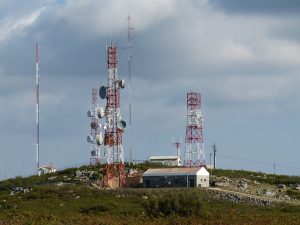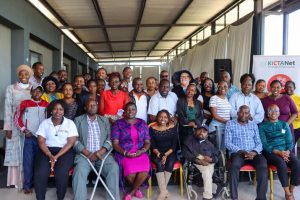Adam,
Some info that CA gives is not in tandem with what KNBS states. See my
*comments* below
On Thu, May 27, 2021, 5:45 PM Adam Lane via kictanet <
[email protected]> wrote:
> Hi Mwendwa
>
> The framework is a positive step. Though Kenya has some of the best
> connectivity on the content, the CA has estimated that around 4% of the
> population do not have broadband network coverage and the business models
> of providing it in those areas are difficult (expensive to provide, few
> users, users have low incomes etc). Whether Community Networks are able to
> provide networks in those circumstances and at scale may be unclear but
> they should certainly be given a chance.
>
*Kenya has a youthful rural population; the latest data from the census
2019 by the Kenya National Bureau of Statistics (KNBS) reveals. In this
case, 35.7 million Kenyans (75.1%) are below 35 years, while 32.73 million
(68.9%) live in rural areas.*
*Source:
kenyanwallstreet.com/census-2019-datashows-kenya-has-a-youthful-rural-population/
<kenyanwallstreet.com/census-2019-datashows-kenya-has-a-youthful-rural-population/>
*
*Given these details, I wonder how we can reconcile the figure to 4% not
covered by broadband.*
*The framework is definitely a step in the right direction.*
> I also want to commend the report for noting the critical issue of
> demand-side aspects of broadband usage (awareness, skills, access to
> devices, relevant local content etc). Addressing those issues are beyond
> the scope of the regulatory framework which is for licensing, but certainly
> it is good to note that Community Networks might be more willing to invest
> in those areas, and thus benefit from having more users.
>
*The aim of the framework while stated is for licensing however, the
licensing is focused on addressing a bigger issue – The Digital Divide. *
*If the license were not to focus on matters digit literacy, availability
of digital devices, power then it will simply be putting regulation over
nothing. The Digital Divide is very real and it cannot be addressed piece
meal.*
> Since the stated purpose of the framework is to provide network coverage
> where it does not exist, my suggestion would be that Community Networks
> should certainly be given a chance in those un-served areas, and in those
> areas (88 sub-locations with 0 coverage, 239 sub-locations with <50%
> coverage for example) the CA needs to provide some efforts to reduce the
> costs of providing networks, including lower licensing fees, and lower
> spectrum costs. This should be for any operator, whether a community
> network, ISP or MNO. Since currently it is difficult for community networks
> to register, then certainly it is a good idea to make it easier for them to
> register and try to build a viable network.
>
*Unserved areas exist within cities. Take an example of Nairobi; we have
Poa Internet, Tunapanda serving the masses where major telcos have failed.
The question is not only about coverage but also about affordability.*
*Mombasa has Muoroto, Bangladesh, Kisumu Ndogo… all remain unserved. Yet
the town is teaming with all ISPs fighting for businesses within CBD and
industrial areas of Shimanzi.*
> However it is strange that the suggested size is of “sub-county†rather
> than sub-location or ward; and strange that there is no limitation on
> location such as “no existing network coverageâ€. I would recommend a
> limitation on the size to be much smaller than sub-county, and more
> importantly, I would recommend a limitation on the community network to
> operate in areas that are un-served by other network providers (these areas
> are now well known following the Access Gaps Study this year).
>
*Limiting areas for CNs to the neighborhood would make no sense in as far
as CNs normally operate. Take examples of CNs in Africa…*
*Zenzeleni – **https://zenzeleni.net/our-journey/
<zenzeleni.net/our-journey/> it covers at least a span of 60km if
not more by now. This is equivalent to the distance between Mombasa and
Kilifi, Mombasa and Kwale, etc. CNs should not be restricted within
locations.*
*The last ACCESS GAPS Study am aware of was done in 2016, as per CA’s
website an EOI is dated to begin and end on 27/05/2021 –
**https://ca.go.ke/document/expression-of-interest-eoi-for-consultancy-services-to-undertake-ict-access-gaps-study-in-kenya
<ca.go.ke/document/expression-of-interest-eoi-for-consultancy-services-to-undertake-ict-access-gaps-study-in-kenya>*
/
>
> The way the current framework is written would allow community networks to
> operate in sub-counties of Nairobi or any other cities/towns, and be in
> direct competition to MNOs and ISPs, which I don’t believe is the purpose
> of the framework.
>
>
>
> Should the purpose of the framework be to address affordability issues of
> broadband (i.e. if affordability is one barrier of broadband usage along
> with devices access, skills, awareness, content, power etc), then I believe
> a different regulatory strategy could be developed to address this. This
> framework for community networks should be limited to areas that are
> un-served only.
>
>
>
> Regards
>
> Adam
>
>
>
> *From:* kictanet [mailto:kictanet-bounces+adam.lane=
> [email protected]] *On Behalf Of *Mwendwa Kivuva via
> kictanet
> *Sent:* Thursday, May 27, 2021 9:28 AM
> *To:* Adam Lane <[email protected]>
> *Cc:* Mwendwa Kivuva <[email protected]>
> *Subject:* [kictanet] Licensing and Shared Spectrum Framework for
> Community Networks for Kenya online discussion
>
>
>
> Dear Listers,
>
>
>
> As we had indicated, today we will have a discussion on the Licensing and
> Shared Spectrum Framework for Community Networks for Kenya that was issued
> by the Communications Authority of Kenya, available for direct download
> here
> <ca.go.ke/wp-content/uploads/2021/05/Licensing-and-Shared-Spectrum-Framework-for-Community-Networks-May-2021.docx.pdf>
> .
>
>
>
> Today, we will discuss the licensing aspect of the community networks. and
> tomorrow about the shared spectrum framework.
>
>
>
> The Community Network Licensing framework proposes;
>
> 1. Community Network Service Provider (CNSP) License to be created within
> the Unified Licensing Framework.
>
> 2. The community network should be fully controlled by a non-profit entity
> and carried on for non-profitable purposes, encouraging members of the
> community to participate in the governance, design, and operationalisation.
>
> 3. Two letters of support from Community Leaders as part of the
> application process for CNSP to ensure community ownership
>
> 3. Geographical coverage of a CNSP will be a sub-county boundary
>
> 4. License period of 10years with License Application fee Ksh1000, Initial
> Operating License Fee Ksh 5000, and Annual Operating Fee Ksh5000.
>
> 6. Spectrum Fee: Fee waiver for non-protected access to lightly-licensed
> and license-exempt frequency bands by wireless access systems
>
> 7. CNSPs would be exempt from USF contributions, while the USF
> implementation framework may include a community ICT development and/or
> capacity building component. The authority shall further examine ways to
> ensure that community networks receive consideration under the future
> framework for the Universal Service Fund
>
>
>
> Questions:
>
> =========
>
> – What are your comments on the proposed licensing framework?
> – What gaps have you identified in the proposed licensing framework?
> – How would you recommend addressing the identified gaps?
> – What recommendations do you have for CA to improve entry into the
> telecommunications market in Kenya?
>
>
>
> Looking forward to an engaging discussion.
>
>
>
> ______________________
> Mwendwa Kivuva, Nairobi, Kenya
> www.linkedin.com/in/mwendwa-kivuva
> _______________________________________________
> kictanet mailing list
> [email protected]
> lists.kictanet.or.ke/mailman/listinfo/kictanet
> Twitter: http://twitter.com/kictanet
> Facebook: www.facebook.com/KICTANet/
>
> Unsubscribe or change your options at
> lists.kictanet.or.ke/mailman/options/kictanet/twahir%40hussein.me.ke
>
> The Kenya ICT Action Network (KICTANet) is a multi-stakeholder platform
> for people and institutions interested and involved in ICT policy and
> regulation. The network aims to act as a catalyst for reform in the ICT
> sector in support of the national aim of ICT enabled growth and development.
>
> KICTANetiquette : Adhere to the same standards of acceptable behaviors
> online that you follow in real life: respect people’s times and bandwidth,
> share knowledge, don’t flame or abuse or personalize, respect privacy, do
> not spam, do not market your wares or qualifications.
>
_______________________________________________
kictanet mailing list



